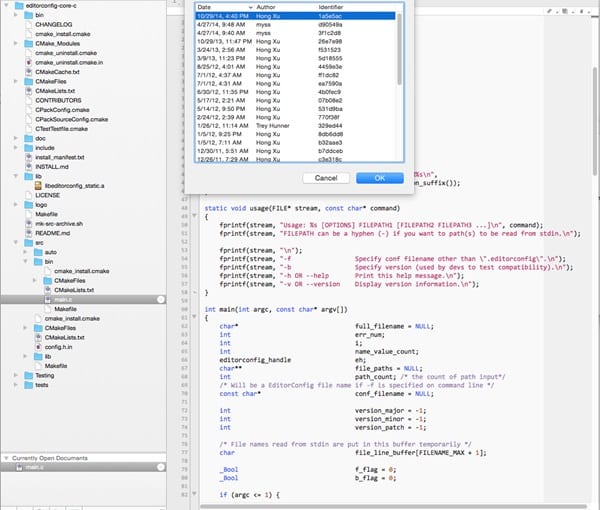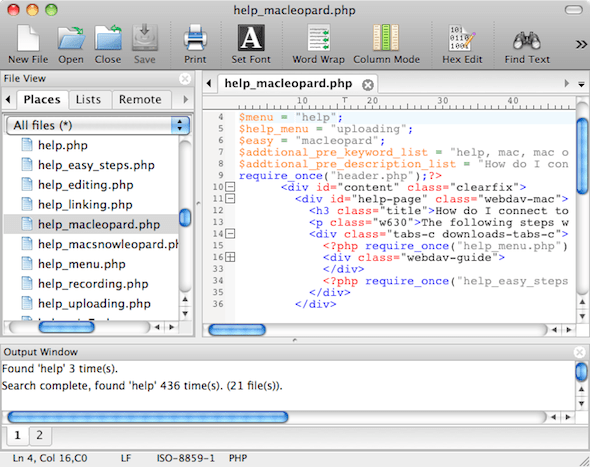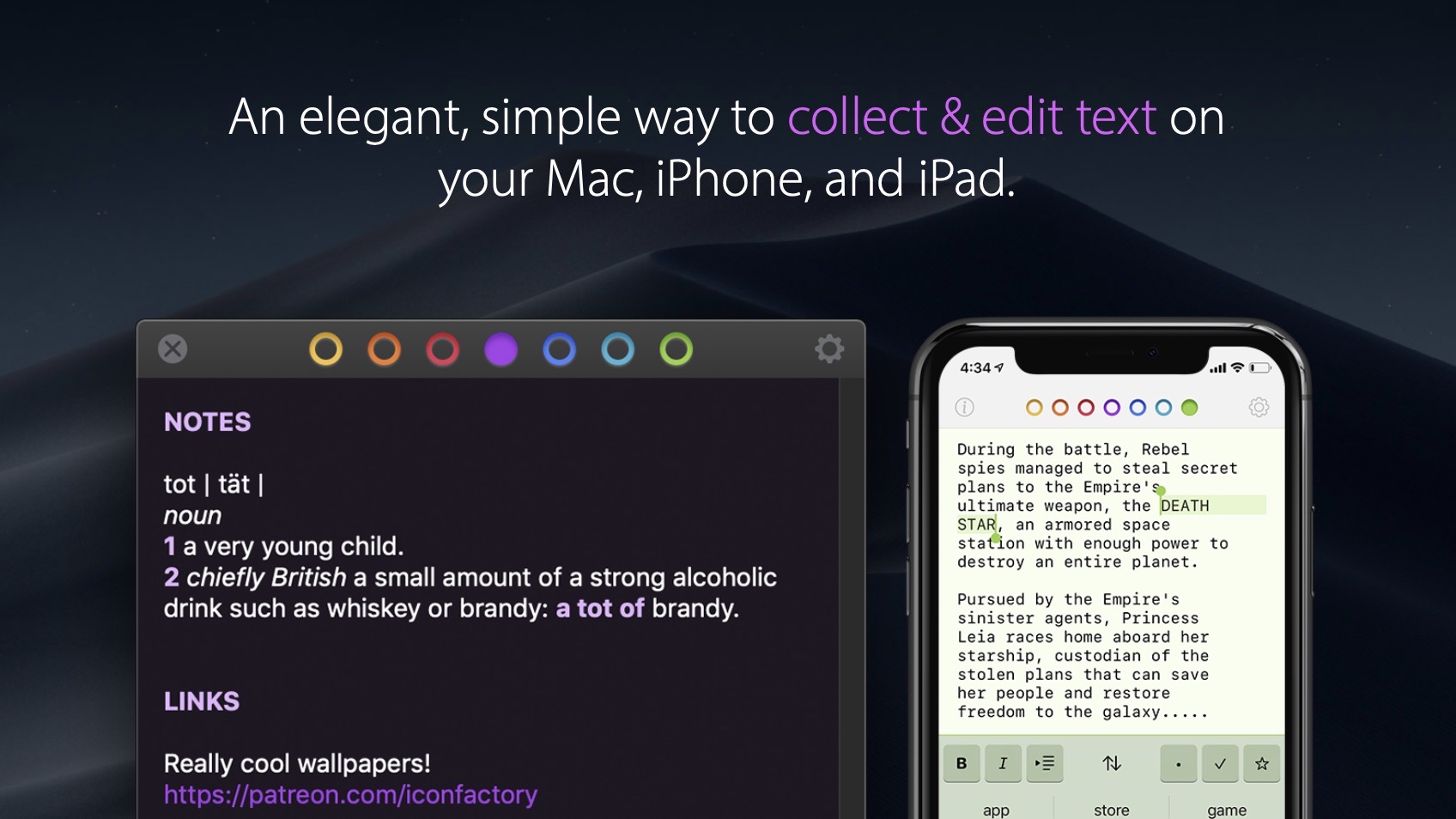Mac Snow Leopard makes it easy for you to create and edit your text files, such as word-processing files. Text files let you create and format documents that include text and photos and even embed music and video files for Web pages you build. Virtually every computer ever built can read and write in standard. 0xED seems to be the most simple and user-friendly of the free options out there. Just download and run, and get a side-by-side hex/ASCII view. Text editors work too, but often don't have very good binary-level editing/display options. Plus 0xED is incredibly fast; you can browse in realtime through a 1 GB file. – Beejor Sep 29 '18 at 16:51.
You can make writing code as complicated as you want, but at the end of the day, all you really need is your favorite, trusty text editor. You can use a simple one like Microsoft’s Notepad, but oftentimes it’s helpful to have a text editor that has syntax highlighting/coloring, support for multiple languages, a robust find and replace feature, and other features and options that make writing code just a tad bit easier.
If you’re in search of a good, free text editor – you’ve come to the right place. Below you’ll find 12 first-class free text editors that are designed with coders’ needs in mind. Whether you use a Windows, Mac, or Linux machine – you’ll find a few options here that will satisfy your code-authoring needs.
NOTEPAD++
Sep 15, 2021 What is TextEdit? TextEdit is a free word processor that comes preinstalled with your Mac computer. It has been around for over 25 years and it is an easy way to open and read word files, text files and even HTML files. How to create an HTML file in TextEdit. Go to Finder Applications TextEdit. Double click on TextEdit to open. Answer (1 of 8): Two ways 1. Open your Application folder and type the letter ‘T’. That will get you near TextEdit in the list. (Do the same with the Applications icon in the Dock and you will be near TextEdit. Use the arrow keys to navigate.) 2. I use CMD-SPACEBAR to open the Spotlight search. Another notable feature of this Mac-only text editor is the ability to enhance the real-time text editing, thanks largely to the well-timed segregation into three columns that consist of the code editor, navigator, and files. Thus, you can comfortably keep an eye on the many sections of the code you are working on; without having to hop from. New Mac users may not know about TextEdit, a simple but deep text editing and word processing tool that comes with your Mac. Convert rich text documents to other formats. With TextEdit, you can open and edit rich text documents created in other word processing apps, including Microsoft Word and OpenOffice. You can also save your documents in a different format, so they’re compatible with.
(Windows)
NOTEPAD++ is the premier replacement for Microsoft’s Notepad. It has an auto-completion feature (for most supported languages) that guesses what you’re trying to write, a tabbed interface which is great for working with multiple files without cluttering your task bar, a powerful RegEx find-and-replace feature, code folding, support for a large array of languages (even Assembler!) and much more. These are just some of the features that make NOTEPAD++ my personal default text editor.

Bluefish Editor
Text File Editor For Mac Download
(Mac, Linux)
Bluefish Editor is a robust, open source text editor geared towards programmers and web designers. It’s known as being a fast, lightweight text editor that can open 500+ documents with ease. It has a built-in function reference browser (for PHP, Python, CSS, and HTML) so you can quickly learn about with particular syntaxes. Check out the Screenshots section to find movies/screencasts (such as learning about working with remote files) and screen shots of Bluefish Editor.
TextWrangler
(Mac)
Free Mac Text Editor
TextWrangler is a multi-purpose text editor for the Mac OS. It is a programmer-friendly text editor and Unix/Server Admin text editor. It has a useful “plugin” system allowing developers a way for extending TextWrangler’s built-in features. It also has a function browser so that you can quickly find and jump to the function you’re looking for (very helpful for those really long files).
Smultron
(Mac)
Smultron is an easy-to-use text editor. Its simple interface makes it perfect for the minimalist coder. It has the basic features you’d expect from a text editor such as syntax highlighting/coloring but also has cool, helpful features such as the ability to split the viewing pane in two so that you can view files side-by-side, a code snipplet library to allow you to store your often-used code blocks, and a full-screen mode that’s intended to make you focus on the task at hand.
Caditor
(Windows)
Caditor is an open source portable text editor written in the .NET framework (C#) that puts speed and performance at the forefront of its design. It has a convenient search box built into the tool bar of the text editor’s interface so that you don’t have to open another dialog box to perform a search. It has other handy features common to developer-oriented text editors such as line numbering, a compiler feature to allow you to hook it up with your compiler, and FTP feature.
gedit
(Linux)

gedit is the official text editor of the GNOME desktop. Unlike Microsoft’s built-in text editor (Notepad), gedit is a more feature-packed text editor geared towards usage for programming and mark-up. With its syntax highlighting, tabbed interface for editing multiple files, and spell-checking feature – gedit is an excellent, free text editor for coders.
GNU Emacs
(Windows, Mac, Linux)
GNU Emacs (more commonly referred to simply as Emacs) is a cross-platform, extendable text editor geared towards programmers. One of its defining features is Emacs’s ability to be extended – offering you the ability to use it as your project planner and debugger, among other things. It has a file-comparison feature (M-x ediff) that highlights differences between two files (useful for figuring out changes in a file made by coders who don’t document/comment their revisions).
Crimson Editor
(Windows)
Crimson Editor is a lightweight text editor for Windows that supports many languages. It has a “Macros” features which lets you record a sequence of tasks so that you can reuse the sequence with a click of a button. It has a built-in FTP feature, allowing you to upload/download files from your FTP server. Crimson Editor is a solid option for Windows users.
ConTEXT
(Windows)
Text File Editor
ConTEXT is another excellent, light-weight, freeware (meaning it’s free – but close-sourced) text editor for Windows. It has countless of handy features such as text sorting (helpful when you need to sort things in alphabetical order, for example), the ability to export configuration options so that you can share your configuration or import it into several machines, and a macro recorder for repeating a sequence of tasks. In 2007, ConTEXT development was turned over to David Hadley but continues to be freeware.
SciTE
(Windows, Linux)
SciTE, written on top of the open source Scintilla code-editing component, is a speedy text editor aimed for use in source code editing. It has a standalone .exe version which you can use for portable storage drives (i.e. USB flash drives) so that you can conveniently carry it around and use it on any computer without having to install it. SciTE is compatible with Windows and Linux operating systems and has been tested by the developer on Windows XP and on Fedora 8 and Ubuntu 7.10.
Komodo Edit
(Windows, Mac, Linux)
Komodo Edit is a freeware, cross-platform text editor created by ActiveState. It is a simple text editor based on the popular integrated development environment – Komodo IDE. It has a convenient and flexible Project Manager feature to help you organize and keep track of your project files.
jEdit
(Windows, Mac, Linux)

Text File Editor For Mac Shortcut
jEdit is a text editor that specifically caters to programmers. It’s written in Java and runs on any operating system that supports You can download a ton of plugins (check out the Plugins Central on jEdit’s website) to extend its built-in features. jEdit was designed to combine the best features of Windows, Mac, and Unix text editors.
Additional Resources
- Comparison of text editors (Wikipedia)
- Hive Five: Best Text Editors (Lifehacker)
What do you think?
Find one that you like the best and stick to it, as everything down to the text can influence your clients’ web reputation whether they are a golf course or a restaurant. There’s a ton of text editors out there so be sure to share your experiences and opinions on the text editors above, and if your favorite isn’t on the list – please tell us about it in the comments.
Related Articles
- Best In-browser Development Tool?
Best Free Mac Text Editor
A text (TXT) file contains unformatted text with the file extension .txt (e.g., macreports.txt). By unformatted, it is meant that these type of text files are plain text files without any styling and formatting, for instance, these documents do not have bold texts, italic texts, images, colors, different font types, hyperlinks, tables, bulleted lists etc. These documents just have plain texts. A TXT file can be created, opened and edited on a Mac with a text editor. An example of a text editor is TextEdit, which is included with the macOS software. Here is how you can create a text file:
Open and use TextEdit and create a text file
- Open the TextEdit app on your Mac (Applications > TextEdit, or use Spotlight, press Command-Space bar, to search, find and open TextEdit). TextEdit is a text editing and word processing tool that comes with your Mac.
- In the TextEdit app, choose File > Open. TextEdit has two format modes: (a) plain text (.txt file) and (b) rich text (.rtf file). The difference is that .txt mode will not allow formatting, while .rtf mode will let you format like adding images, colors, tables etc.
- Default format is rich text format. You can change this by going to TextEdit > Preferences and select Plain Text.
- You can also change the mode while you editing your text by going to Format > Make Plain Text or Format > Make Rich Text. If you change a .rtf file (rich text) to .txt file (plain text), your document will lose all formatting options.
- Create and edit your text file
- And then go to File > Save to save your text file.
- Name your file and save it.
Text File Editor For Mac
You can also create more rich documents, you can use Pages, Pages for iCloud or similar apps. One other note is that text files are also known as flat files or ASCII files.
Html Text Editor Mac
Textedit For Windows
See also: Where Do Screenshots Go On Mac?
Text Editor For Mac
All files can be categorized into one of two file formats — binary or text. The two file types may look the same on the surface, but they encode data differently. While both binary and text files contain data stored as a series of bits (binary values of 1s and 0s), the bits in text files represent characters, while the bits in binary files represent custom data.
Binary Files
Binary files typically contain a sequence of bytes, or ordered groupings of eight bits. When creating a custom file format for a program, a developer arranges these bytes into a format that stores the necessary information for the application. Binary file formats may include multiple types of data in the same file, such as image, video, and audio data. This data can be interpreted by supporting programs, but will show up as garbled text in a text editor. Below is an example of a .PNG image file opened in an image viewer and a text editor.
As you can see, the image viewer recognizes the binary data and displays the picture. When the image is opened in a text editor, the binary data is converted to unrecognizable text. However, you may notice that some of the text is readable. This is because the PNG format includes small sections for storing textual data. The text editor, while not designed to read this file format, still displays this text when the file is opened. Many other binary file types include sections of readable text as well. Therefore, it may be possible to find out some information about an unknown binary file type by opening it in a text editor.
Binary files often contain headers, which are bytes of data at the beginning of a file that identifies the file's contents. Headers often include the file type and other descriptive information. For example, in the image above, the 'PNG' text indicates the file is a PNG image. If a file has invalid header information, software programs may not open the file or they may report that the file is corrupted.

Text Files
Text files are more restrictive than binary files since they can only contain textual data. However, unlike binary files, they are less likely to become corrupted. While a small error in a binary file may make it unreadable, a small error in a text file may simply show up once the file has been opened. This is one of reasons Microsoft switched to a compressed text-based XML format for the Office 2007 file types.
Text files may be saved in either a plain text (.TXT) format and rich text (.RTF) format. A typical plain text file contains several lines of text that are each followed by an End-of-Line (EOL) character. An End-of-File (EOF) marker is placed after the final character, which signals the end of the file. Rich text files use a similar file structure, but may also include text styles, such as bold and italics, as well as page formatting information. Both plain text and rich text files include a (character encoding| characterencoding) scheme that determines how the characters are interpreted and what characters can be displayed.
Since text files use a simple, standard format, many programs are capable of reading and editing text files. Common text editors include Microsoft Notepad and WordPad, which are bundled with Windows, and Apple TextEdit, which is included with Mac OS X.
Textedit App Mac
Unknown Files
Apple Textedit App
If you come across an unknown file type, first look up the file extension on FileInfo.com. If the file does not have an extension or you are unable to locate the file type, you can attempt to open the file in a text editor. If the file opens and displays fully readable text, it is a text file, which you have successfully opened.
Text Editor Mac Free
If the file opens and displays mostly garbled text, it is a binary file. While the file is not mean to be opened in a text editor, there may be some clues within the text that reveal information about the file type, like in the PNG example above. This may help you determine what program you need to open the file correctly. Finally, if the file will not open in a text editor, it is a binary file that can only be opened by the appropriate program.